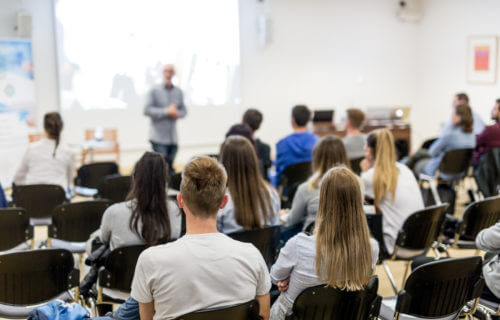RIVERSIDE, Cali — Whether you’re too slow to take down all the notes or prefer to spend your time listening, more and more students are using their phones to take pictures of an instructor’s lecture slides. To some, taking photos might seem unproductive, even lazy, if you snap a picture and never look at it again. But a new study finds taking a photo helps students remember both the slide and spoken-word content.
The experiment was conducted in two parts. The first involved testing how much students retained the course material if they studied or did not study the slide pictures before the test. Past experiments have looked at people’s memory after photographing information. In those studies, taking photos in museum galleries—used to mimic photo-taking outside the classroom—hurt people’s retention of the photographed content when they were asked questions about it later.
To the study authors’ knowledge, this is the first study that considered pictures of lecture slides as an academic tool for studying. “Given that the floodgates have already opened regarding the use of technology in the classroom – particularly with the proliferation of online courses offered due to COVID-19 – it is wise to study how best to support learners’ use of technology in the classroom so we can understand how best to support their learning with these devices,” comments Annie Ditta, an assistant professor teaching at the University of California, Riverside and lead study author in a statement.
The first half of the study involved 132 students who took photos of alternate PowerPoint slides on their computer screens. Half of the group snapshotted even-numbered slides and the other took pictures of odd-numbered slides. The PowerPoint presentations were on subjects that would not seem so familiar for a psychology student such as printmaking, fencing, and cheese-making. After going over the lecture, students completed a 60-question fill-in-the-blank test involving questions from both the slides and the spoken-word-only portion of the teacher’s lesson.
Students who took pictures of the slides remembered the slide content better than those that did not take photos. However, there was no difference in memory recall when information was presented orally.
The second experiment gave half the participants the option to take pictures of their choice of slides, as long as they photographed about half. The other half were instructed to only take photos of the slides other people chose to photograph.
The findings showed it did not matter whether the students were the ones in charge of choosing photos or mimicking others’ photo-taking. Both groups remembered slide-photographed content better than non-photographed content. But one surprising benefit was that taking the slide photos helped their memory of information delivered straight from the teacher’s mouth.
While the study did not explain why taking photos help with memory retention, the study authors suggest that “the predictability of taking a photo every other slide enabled participants to pay more attention to the upcoming to-be-photographed slides in experiment 1.” Future studies will research an answer on why it helps along with comparing the benefits of photo-taking versus traditional note-taking.
The study is published in the Journal of Applied Research in Memory and Cognition.

